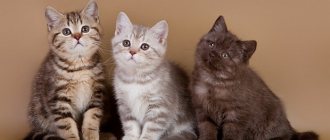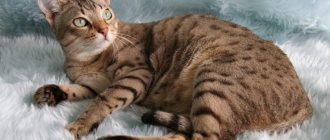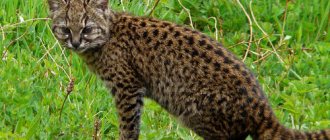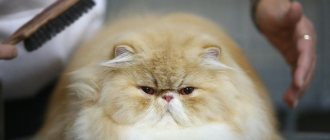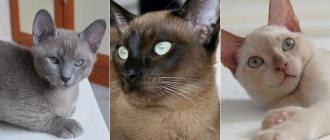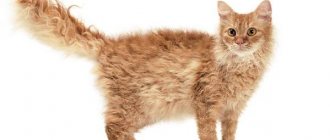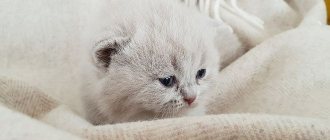This type of cat dates back more than 400 years. Its appearance in America is associated with the arrival of the first settlers to the continent. On the ships of that time, cats were the only remedy against rats, which were found in abundance on ships and thoroughly spoiled the provisions. Therefore, sailors took unpretentious, strong and large cats capable of exterminating an army of rodents.
The functionality of these cats turned out to be indispensable on land, for fighting rodents in barns, houses and fields.
These cats are unpretentious and friendly in everyday life, they are distinguished by a strong body and powerful paws suitable for real hunting. It is best to look at a photo of an American Shorthair cat to get an idea of its appearance.
Currently, shorthaired pointers in America stand alongside national symbols such as the Christmas duck, baseball or apple pie.
Brief history of the breed
Presumably the cats that became the ancestors of the American Shorthair were brought to the New World at the beginning of the 17th century by a group of British Protestants.
The cats they brought were forced to adapt to the new climate and changed living conditions. Gradually, the tailed ratcatchers increased in size and acquired thicker, coarser fur.
Until the beginning of the 20th century, cats did not arouse interest among overseas felinologists, but then American breeders seriously began breeding these hardy animals.
In 1904, the CFA registered the Buster Brown, a direct descendant of cats introduced by British colonists. And in the middle of the 20th century, a catalog was published, which included about 50 representatives of the breed known as domestic shorthair.
In 1965, the cats were renamed American and a program for the development and preservation of their purebred was developed.
Castration and sterilization
In cases where breeding of a breed is of no interest to the owner, it is advisable to sterilize or castrate the pet.
Castration is an operation to completely remove the reproductive glands of cats. In males, the testes are cut out, in females - the ovaries. After such an operation, the production of sex hormones completely stops, the animals become unable to reproduce and stop all manifestations of sexual behavior. Thus, in cats, aggression and the desire to mark territory disappear, and in cats, manifestations of estrus disappear.
Sterilization is considered a more gentle operation. It involves ligating the vas deferens in cats and the fallopian tubes in cats. At the same time, the body continues to produce sex hormones, which promotes sexual desire, but the animal does not become pregnant.
Experts consider the optimal age for castration or sterilization of a cat to be from 6 to 12 months.
There are 2 opinions regarding the most favorable age for such operations in cats:
- The period is from 3 to 6 months or until the onset of the first heat. Proponents of this theory explain this by the fact that at this age a cat can more easily tolerate any surgical intervention. It also reduces the risk of developing breast tumors in older age.
- Age 10 months. Adherents of this view argue that performing an operation before puberty provokes negative hormonal disorders that can lead to a deterioration in the animal’s behavior.
Caring for your pet after surgery
After surgery, the cat is advised to wear a bandage
In the postoperative period, caring for the animal is not particularly difficult. The cat should wear a bandage for the first days after surgery, and sutures will be removed on days 8–12.
Cats feel great immediately after the anesthesia wears off.
Interesting Facts
During the existence of American women, a lot of interesting things happened to the breed:
- There is a legend that American shorthair cats were present on all the ships of Christopher Columbus's flotilla during his search for India. The legendary navigator believed that animals would save food supplies from rodents and ordered to take them with him. And this is how the ancestors of American women came to the lands of the Indians. True, this version has no documentary evidence and remains simply a beautiful legend.
- The American Shorthair is the national pride of the United States. The cat is considered the same symbol of the country as apple pie or baseball.
- American Shorthairs helped form several other breeds, including the Exotic, Devon Rex, Snowshoe, Scottish Fold and Bengal.
Diseases
These animals, having a strong constitution, are quite hardy.
But some lines of this breed have a predisposition to cardiomyopathy, an inherited heart disease that causes many animals to die in their youth.
Hip dysplasia is also an inherited disease, which can cause the animal to experience pain and limp.
Sometimes American Shorthairs can suffer from polycystic kidney disease, which can cause this organ to fail completely.
Breed description, standards, appearance
The American Shorthair is a harmoniously developed cat whose athletic build corresponds to its purpose as a mousecatcher.
The official breed standard was approved in 1966.
Dimensions and weight
The American is a large cat with well-developed bones, a broad chest and a strong build. Depending on the gender, the weight of representatives of the breed ranges from 5-8 kg.
Anatomical characteristics
A typical American Shorthair cat should fit the following description:
- The head is large with a rounded muzzle, strong jaws, developed cheeks, a pronounced chin and a straight nose.
- The eyes are round and shiny. Widely spaced. The eye color is in harmony with the main coat color. Most often it is copper, yellow or green. White American women are allowed blue irises.
- The ears are medium in size, set wide apart with rounded tips.
- The body is harmoniously built and muscular. The back is level, the shoulders and chest are well developed.
- The limbs are of medium length, straight with round paws. They have parallel posture and heavy muscles.
- The tail is thick at the base, gradually tapering to a rounded tip.
Color and coat type
The American cat has a short, hard-to-the-touch coat, under which is hidden a dense down.
On a note. The density of the American cat's undercoat varies depending on the time of year and the climatic conditions in which the cat lives.
The breed standard provides for more than 60 color options, which are usually divided into smoky, spotted, plain and tabby. The most common colors found in American women are:
- black;
- ginger;
- white;
- cream;
- blue.
On a note. White American women often have heterochromia.
Possible breed defects
Disadvantages of the exterior of American women, in the presence of which the cat does not receive high expert ratings:
- close-set or elongated ears;
- thin or thick tail;
- elongated, stocky body;
- creases on the tail;
- “plush” wool;
- underdeveloped croup.
Defects for which the American Shorthair is subject to disqualification:
- white points;
- deep stop;
- fluffy or long hair;
- goggle-eyed;
- undershot or overshot;
- cryptorchidism.
American females whose coat is colored in the following colors are not allowed for breeding:
- chocolate;
- lilac;
- Burmese;
- Tonkinese;
- cinnamon;
- faun.
Nutrition
Proper nutrition is the key to your pet's health and good mood. From the very beginning, you must decide what type of food your cat will eat, dry or natural food. Mixed feeding is not recommended for cats of this breed.
When choosing dry food, you must take into account the age and lifestyle of your pet. Under no circumstances should you buy cheap food, as it is made from low-quality products and can lead to disease.
When choosing a method of eating natural products, you should take into account some features - the diet should be varied, include different foods, meat and vegetables.
Depending on the age of the cat, food is prepared to varying degrees of readiness. For kittens up to one year old, meat and vegetables are boiled until fully cooked. No need to add salt and spices.
Products you should use are chicken breasts (pre-boil and finely chop), cottage cheese, kefir, boiled vegetables and seaweed, preferably raw and boiled quail eggs, you can add olive oil.
Character and temperament
The American is an easygoing, loving cat, which is not at all characterized by aggressive behavior. She easily tolerates loneliness and quickly adapts to changing conditions. An independent and independent American woman will not bother her owners, persistently demanding attention.
A cat of this breed respects the personal space of others and expects the same in relation to itself.
The American woman has a phlegmatic temperament and is prone to laziness. A cat of this breed is not one of those who will run around the house for hours, ride on curtains and jump on cabinets. Rather, she would prefer to take a quiet nap on a cozy sofa.
Breed and children
Calm and friendly cats get along with kids without any problems. American women are lenient towards childish pranks and tolerate careless treatment.
If cats of this breed get tired of the annoying company of children, they will simply hide high on the closet.
Breed and other animals
American women are able to peacefully coexist with dogs and other medium and large pets. Even if they do not become best friends, they still will not compete for their master’s attention and divide the territory.
Since American females have developed hunting instincts, they cannot be kept together with rodents and ornamental birds.
The history of long-haired cats
The cat was domesticated almost ten thousand years ago in the Fertile Crescent (modern-day Iran). Throughout the history of the world, they were sung and deified, burned at the stake of the Inquisition and persecuted, cherished and cherished. Today, these pets are full-fledged companion animals living next to people.
Long-haired beauties became known to modern man later than their short-haired counterparts.
There are at least four versions of the appearance of cats with long hair in the modern world.
The first story tells that in the sixteenth century, the famous aristocrat and traveler Pietro Della Valle brought several unusually fluffy cats from Persia as a gift to the Pope. The French became interested in the curiosity. Cardinal Richelieu himself patronized extraordinary handsome men and made them famous throughout Europe.
Siberian cat
According to the second version, initially two species of oriental cats with longer-than-usual hair appeared in Europe. And on their basis the Persian cat was bred.
According to the third assumption, the long-haired beauty was brought to Europe from Russia, a country of severe frosts.
The fourth, more plausible, says that long hair appeared in domesticated oriental cats from natural crossing with the wild cat Manul. From him they could well have gotten a flat muzzle, huge round eyes and long thick fur.
Norwegian cat
Scientific theory leans towards the version that the first long-haired cat appeared in Europe more than four hundred years ago. Two types of cats with long hair were brought from Turkey. One species is described as similar to the modern Angora, the second to the Persian cat.
All these theories have a right to exist, but they were and remain only assumptions. Most likely, they owe the appearance of long hair in domestic pets to wild steppe and desert Asian cats, whose habitat in the sixteenth century was the Middle East.
Siberian cat
From France the Persians came to Italy and England. Breeders bred the first European Longhair breed. Since then, there have been two types of long-haired pets. Angora - with an elongated head, flexible and graceful body and silky coat. And massive, heavy and short cats with round heads, flattened noses and long hair with a thick, powerful undercoat - the Persian type.
Angora cats have been known in Persia, India and Afghanistan since the ninth century. Their long snow-white fur and clear blue eyes have always been appreciated.
White Turkish Angora
In the early Middle Ages, cats were treated with reverence and respect; they more than once saved Europe from hordes of rats and mice, and helped stop the plague. These long-haired beauties lived in monasteries with the nuns.
But the times of the Inquisition came and many recently beloved animals were thrown into the fire. Cats with black and red fur were especially affected.
Black Angora
Long hair is undoubtedly the result of natural mutations, and the reason for it was the rather cold climate in the areas where these animals appeared.
The systematization of breeds and systematic selection work in the feline world began quite recently, which is why the history of the origin of beauties with long hair is vague and foggy.
How to choose the right kitten
It is better to purchase an American female from a specialized nursery that breeds this breed. Before purchasing, be sure to read the documents for the brood and inspect the living conditions of the animals. If everything is in order with cleanliness and papers, you can safely proceed to choosing a baby.
A healthy kitten of this breed has shiny fur, a soft belly, clear eyes and an excellent appetite. The little American girl's skin is clean, without redness or scratching. He shows interest in everything that happens and is not afraid of strangers.
Kitten care
Conscientious breeders transfer American females to new homes no earlier than they are 12-16 weeks old. By this age, kittens are already quite independent. They know how to eat, are litter box trained and know the scratching post. Of course, they will need some time to adapt to the changed conditions, but this process goes very quickly.
In order for the tailed pet to feel comfortable in its new home, at first it is given more attention and fed what the breeder gave it. And to facilitate the process of caring for an American Shorthair kitten, they purchase in advance:
- bowls for water and food;
- tray and filler;
- toys;
- carrying bag;
- bed or house;
- scratching post;
- grooming tools;
- hygienic cosmetics.
Important! American Shorthair kittens are very curious and try to play with everything that comes their way. Therefore, for their safety, wires are well secured in the house and all small objects are hidden.
Description
The American Shorthair cat is famous for its gentle and calm character, beautiful coat and excellent health.
Agile, muscular cats terrified rodents
Appearance
The appearance of the “American women” corresponds to their natural purpose. Ratcatchers look like real hunters.
Appearance must comply with the breed standard accepted by the WCF:
- The body is medium-sized or large, strong, muscular. The round chest is well developed.
- The head is quite large. The muzzle appears rounded, but is slightly longer than wide. Well developed cheeks, strong chin, forehead and skull slightly rounded. The nose is straight, of medium length and uniformly wide. The base of the nose at the forehead should be visible. The neck is of medium length, muscular.
- The limbs are thick, strong, of medium length, tapering evenly to strong round paws.
- The ears are medium in size with rounded tips and may have tufts. There is a wide distance between the ears. The height approximately corresponds to the width at the base.
- The coat is short and thick, dense and shiny.
- The tail is of medium length with a wide base, slightly tapering to a rounded end.
- The eyes are round, open, widely spaced, slightly slanted, shiny. They have a pure color - green, yellow, copper or blue.
The color palette of American Shorthair cats is varied.
Rock defects
A defect or defect in the breed may not be immediately noticeable. But the requirements for show animals are very strict. Serious defects may disqualify a pet:
- crease of the tail;
- the bridge of the nose protruding more than usual;
- bulging eyes;
- malocclusion;
- jaw distortion;
- fused fingers;
- gait defect (lameness, wobbling gait);
- excessive length and/or waviness of the coat;
- presence of white spots;
- weight discrepancy;
- eye color.
If the tail is too short or the body is too rough, the cat (or rather, its owner) will face a fine.
Character
By nature, a cat of this breed is peaceful, calm and flexible. Independent, like most of her relatives, she loves to purr and cuddle only when she wants it. If the owners are away from home all day, the cat will calmly endure loneliness. Moderately lazy, she will not tear your home to pieces, but will calmly watch what is happening around her, or go to bed.
In the absence of the owner, the cat will observe the outside world or sleep
The cat is friendly, loves adults and children, and quickly makes friends with other pets. Gentle and sociable, but at the same time quite independent and self-sufficient. He accepts courtship with pleasure and responds with boundless affection and tenderness. Loves people without exception, without dividing into friends and foes.
Despite its calm and slightly lazy character, the cat will always happily respond to the desire to play. The hunting instinct is well developed: cats love to catch mice and various rodents, even if they are not real.
“American” is a brave, strong, hardy and smart cat. Don't be surprised if she brings you a couple of rodents as a gift, proving her devotion and usefulness. When it comes to food, they are greedy; they try to eat in a secluded place and will not share with anyone.
Cats of this breed have some interesting features: they are not afraid of water and bury food reserves.
Video: details about the American Shorthair breed
Care and maintenance
Since the American has a dense undercoat, she can live in the yard during the warm season. In general, this cat breed is quite unpretentious; caring for it comes down to basic hygiene and proper feeding.
Hygiene procedures
In order for the cat to look neat, it is provided with appropriate care:
- The American Shorthair's eyes and ears are regularly wiped with a damp cloth or cotton pad and inspected for any purulent or foul-smelling discharge.
- Brush your cat's teeth weekly with a silicone brush and a small amount of non-foaming toothpaste. This procedure helps prevent the appearance of plaque and stone. That’s why American women are taught it from an early age.
- A cat's claws wear down naturally, but if necessary, they can be carefully trimmed with a nail clipper. They do this as carefully as possible so as not to damage the blood vessels of the American woman.
Grooming
Cats of this breed are quite clean and do not like water. That’s why American women are bathed no more than 3-4 times a year. Bath procedures are carried out in a warm room where there are no drafts.
The cat's fur is moistened with warm water, thoroughly lathered with a special shampoo and rinsed. The bathed pet is dried with a towel and, if necessary, dried with a hairdryer.
Brush the American Shorthair using a rubber brush or a special glove with silicone growths. In normal times, this is done once a week, during seasonal molting - daily.
Tray
The American Shorthair is large in size and also loves to dig. Therefore, a spacious tray with high sides is selected for it. Any filler can be used. The main thing is that it absorbs moisture well.
On a note. In order not to spend money on filler, you can buy a tray with a mesh for the American woman. But you will have to wash it several times a day.
American Longhair Cat
Story
The American Longhair cat is a relatively young breed that is quickly gaining popularity in Europe and America. These animals appeared when a group of breeders wanted to create a breed that had the eyes of Persian cats and the appearance of an American Shorthair, but everything turned out completely differently.
The American Longhair has a coat that's a cross between an American Shorthair and a Persian in length, a slimmer build, and that's basically it. Apart from the fact that some individuals have not semi-long, but long hair, others, due to a recessive gene responsible for hair length, have short hair altogether.
That is, cats of this breed are born in three variations out of three possible - long-haired, semi-long-haired and short-haired. At first they wanted to call the breed “Silver Longhair,” but again everything did not go as planned by the breeders; an incredible number of colors and their combinations appeared, and the cats were called American Longhair.
Breeders tried to add other cats to the breeding program in order to develop the breed and give it the desired qualities. For this purpose, British Shorthairs, Burmese and Russian Shorthairs were taken, although, in the end, the resulting individuals still had to be crossed with Persians to increase the length of the coat. Persian cat breeders initially expressed their disapproval of the new breeding program and the emergence of a cat breed that (in their opinion) could not be called independent.
Despite this, the American Longhair cat is already registered in many international registries, and is quickly winning not only the hearts of the felinological community, but also the hearts of ordinary cat owners. In order for a cat to be recognized as an American Longhair, it must have a clearly traceable pedigree that includes Persians.
Description
These cats are an excellent choice for anyone looking for an affectionate and kind companion. Although they form strong bonds with their owners, these animals are quite capable of being left alone at home if you go to work. They get along well with dogs and other pets, with the exception of birds, but not always.
The American Longhair has a muscular build, a wedge-shaped muzzle of regular shape, and medium-sized ears. The tail is slightly longer than average, fluffy, the paws are of medium length. The average life expectancy is about 15 years or longer.
Personality
The American Longhair is a very kind and sweet cat with a wonderful character. Despite the fact that they have the blood of Persian cats in their pedigree, in terms of their temperament they are not at all similar to them. These pets are strongly attached to their family, have great friendliness and bestow their affection on each of their loved ones. They do not single out anyone specifically as their owner if they live in a family. However, they also feel great with a single owner, making his life more interesting.
The American Longhair cat is a smart animal, it understands people well, understands their internal state and mood, it is not malicious and unforgiving. But if harm is caused to her, especially unjustified and unfair harm, the cat becomes more withdrawn, timid, and begins to avoid close contact with people. However, this is easy to understand - a person in the cat’s place would react in much the same way. The American Longhair is great with children, and is generally not an aggressive animal, with a good tendency to be patient and gentle.
These four-legged friends have high energy levels, but like all cats, sometimes they just like to sleep on a soft sofa. You need to provide your pet with games, toys, and just need to spend time together, especially since this breed is always happy about it. This breed does not often speak out and prefers to remain silent, although this is not an absolute rule. Gets along well with other animals.
Common diseases
The American Longhair is a healthy breed with no significant hereditary diseases. however, you need to monitor your pet’s diet and living conditions, as even the best health can be undermined.
The American Longhair cat with long or semi-long hair requires regular brushing, at least once or twice a week. You also need to clean out deposits from your eyes every day, and keep your ears clean. Claws are trimmed approximately once a week, and the cat is bathed as needed.
Feeding the cat
The American Shorthair has an excellent appetite and eats both industrial and natural food with equal pleasure. The main thing is to choose one type of food and not mix them. It is advisable to feed your cat at the same time, making sure that she does not have 24/7 access to food.
Complete diet
When feeding American Shorthair, preference is given to super premium or premium products. It contains no questionable additives and contains the entire range of nutrients necessary for the proper development of the animal.
It is best to feed the American Shorthair the following brands:
- Arden Grange;
- Farmina;
- Hills;
- RoyalCanin.
With a natural type of nutrition, the cat's diet is composed so that fresh, lean meat predominates in it. Also, the American Shorthair must be given:
- porridge cooked in water;
- eggs;
- offal;
- vegetables;
- lean sea fish;
- dairy products.
On a note. American shorthair vegetables are given in boiled and chopped form. Otherwise, the cat will simply leave them in the bowl.
It is strictly forbidden to feed animals of this breed with sweets, pork, river fish and any leftovers from the master's table.
Feeding frequency
American Shorthair kittens eat more often than adult representatives of the breed. Therefore, the feeding regimen depends on the age of the pet:
- up to 6 months – 4-5 times a day;
- 6-12 months – 3 times a day;
- from 12 months – 2 times a day.
Vitamins and mineral supplements
With a natural diet, an American shorthair cat may not receive enough microelements. Therefore, representatives of the breed are given vitamin and mineral complexes twice a year.
When selecting such supplements, the individual characteristics of a particular American woman are taken into account and are guided by the recommendations of a veterinarian.
American Curl (longhair)
A distinctive feature of the American Curl is their attractive, unusually curled ears. These cats have an elegant, balanced, moderately muscular, slender and not massive body. They generally have good body proportions and come in a variety of sizes.
Playfulness
- 1
- 2
- 3
- 4
- 5
Activity
- 1
- 2
- 3
- 4
- 5
Friendly towards other pets
- 1
- 2
- 3
- 4
- 5
Child Friendly
- 1
- 2
- 3
- 4
- 5
Need for care
- 1
- 2
- 3
- 4
- 5
Sonority (softness)
- 1
- 2
- 3
- 4
- 5
Need for attention
- 1
- 2
- 3
- 4
- 5
Attachment
- 1
- 2
- 3
- 4
- 5
Obedience
- 1
- 2
- 3
- 4
- 5
Intelligence
- 1
- 2
- 3
- 4
- 5
Independence
- 1
- 2
- 3
- 4
- 5
Endurance
- 1
- 2
- 3
- 4
- 5
About the breed
American Curls make attractive pets for more than just their fancy ears. These cats are human friends who are rarely unfriendly. They are affectionate, but do not bother their owners with demands to give them attention. They love to sit on your lap, touch you, and rub their nose against you. American Curls are easy to teach to play fetch and rarely lose their love of play. They get along very well with children. Although American Curls are not as active as Abyssinians or Siamese, they are quite playful and energetic cats. They also exhibit the natural curiosity of cats and will explore any new additions to their home.
Story
The American Curl appeared in June 1981 as a spontaneous genetic mutation in the domestic cat population. They became popular in 1983, and by 1986 the breed was recognized by the three major North American cat associations. In June 1981, two cats with curled ears turned up on the doorstep of a couple in Lakewood, California. One of the cats soon died, but the second, a friendly long-haired cat, became a member of the family and was named Shulamit. At first, Shulamit's new family paid little attention to her unique curled ears, but rather liked her loyalty and gentle, trusting nature. They assumed that Shulamit was one of many cats with folded ears, even though they found no mention of the supposed Shulamit breed in local libraries and bookstores. In December 1981, Shulamit gave birth to four kittens, two of which were born with the same curled ears. The father, a local long-haired cat, did not have curly ears and, as it soon became obvious, the gene responsible for them. Although the couple didn't understand cat genetics at the time, the point was that the gene that controls curled ears is dominant. That is, only one parent with such a gene is enough for curled ears to appear in at least several kittens in the litter. Likewise, if a cat doesn't have folded ears, then that animal probably doesn't have that gene, since the dominant gene is always externally expressed. Shulamit continued to produce offspring from local cats, increasing the size of the local curl population. Early litters included both long-haired and short-haired cats with a variety of colors, including pointing. The couple gave kittens to friends and relatives. The two kittens ended up with Nancy Kister, who fell in love with their unusual ears and gentle nature. After reading an article about the Scottish Fold, another cat breed with distinctive ears, it occurred to Kister that these kittens might be a whole new breed. It was proven that this is exactly the case, and since then the American Curl has been recognized as an independent breed and began to gain popularity.
Education and physical activity
American Shorthair cats are very smart, but very stubborn and independent animals. Therefore, representatives of the breed can be taught to follow commands or do various tricks. However, this will require patience and perseverance.
In order for the American Smoothhair to have the opportunity to run, it is regularly taken for walks. Cat houses are equipped with a play complex with numerous shelves and ladders.
Reviews about the breed
Anyone who is thinking about buying a kitten of this breed should take into account that they are quite rare and expensive! In the CIS countries, only a few nurseries are engaged in breeding, which are located in Mokva, Sudak and Kyiv. Pavel Litvinov, a famous breeder of American shorthair cats, owner of the STALKER-BARS cattery (Crimea, Sudak), writes about the distinctive features of representatives of the rare breed.
Owners of AKSh kittens share their impressions:
Of course, as cats mature, they will become calmer, but not so much so that they can only sleep and eat all day.
Even into adulthood, American women retain an interest in hunting, games and household chores.
Experts' Opinion on the American Shorthair at the CFA Show
Vaccinations and antiparasitic treatment
American Shorthair cats often die from viral diseases. To prevent the premature death of a pet, it is regularly vaccinated with a complex drug that produces immunity:
- to calcivirus;
- rhinotracheitis;
- panleukopenia.
The first vaccination is given to a kitten at the age of 7-8 weeks. At 11-12 weeks, an American woman is vaccinated against the same diseases and against rabies. Subsequently, the cat is vaccinated once a year.
To protect the American woman from diseases carried by fleas and helminths, she is regularly treated for parasites:
- Antihelminthic medications are given to a cat of this breed once every six months, repeated every 10-14 days.
- To protect against fleas, use special shampoos, drops or collars.
Hereditary diseases of American Shorthair cats
The American Shorthair cat is not susceptible to hereditary diseases. But sometimes some pathologies occur.
Hypertrophic cardiomyopathy
Hypertrophic cardiomyopathy (HCM) is an inherited heart disease that involves thickening of the muscle wall. It is a common cause of early death in many cats.
The insidiousness of HCM lies in the fact that the disease is difficult to diagnose and in the early stages is asymptomatic. Symptoms may appear at a stage when it is impossible to help the pet. Veterinarians recommend that owners of breeds prone to HCM undergo cardiac ultrasound monitoring twice a year. If the disease is detected in time, it can be successfully treated. If you are planning any surgical intervention using anesthesia (for example, sterilization), you must first consult with a veterinary cardiologist.
In hypertrophic cardiomyopathy, the walls of the heart's ventricles thicken, making it difficult for the heart to function properly.
The first symptoms you should pay attention to are fatigue and shortness of breath (fast breathing with your mouth open). One of the complications of HCM is thromboembolism (formation of blood clots and blockage of vital vessels). The femoral arteries are most often affected. The animal is in pain and cannot rise on its hind legs. With timely help from veterinarians, blood flow can be restored and negative consequences can be avoided.
Tests to determine this disease in animals are common in America . Catteries offer cats for sale after conducting research in order to exclude unhealthy animals from breeding work. Some nurseries in Russia also confirm with research the absence of HCM in their kittens.
Hip dysplasia
Feline hip dysplasia is most often an inherited condition . The disease causes pain and lameness in the animal. The cat becomes inactive, its gait becomes uncertain and wobbling. The cat chooses how to place its paw in order to feel less pain and discomfort, cannot jump on a chair, falls to the side and cannot get up quickly, while meowing in pain. Not only an animal with a hereditary predisposition, but also an overweight pet with an unhealthy diet can develop hip dysplasia.
Surgical treatment of hip dysplasia is indicated only for young, strong cats.
Diagnosis is made based on the above symptoms, tests and x-rays. For treatment, painkillers, anti-inflammatory drugs, vitamins and diet are prescribed. The surgical treatment method can only be applied to healthy and young cats.
Polycystic kidney disease
Polycystic kidney disease is a serious hereditary disease that can cause organ failure. The disease progresses slowly, causing irreversible processes in the kidneys.
Symptoms:
- lethargy;
- loss of appetite;
- thirst;
- frequent urination;
- weight loss;
- vomit.
With polycystic disease, many cavities filled with fluid form in the kidney
Diagnostics consists of:
- blood test;
- urine analysis;
- ultrasound examination.
Treatment:
- diet with limited protein and phosphorus;
- subcutaneous fluid injection;
- preparations for removing phosphorus;
- taking vitamin D;
- taking antacids (to prevent vomiting);
- mandatory blood pressure monitoring.
Sick cats do not participate in further breeding of the breed, since when crossing a healthy and sick animal, half of the kittens will inherit the disease.
Currently, it is possible to conduct special tests to determine genetic pathologies.
Pros and cons of the breed
Like any other cat breed, American Shorthairs have both advantages and disadvantages.
| pros | Minuses |
| Unpretentiousness | Laziness |
| Lack of aggression | Tendency to solitude |
| Attractive exterior | Predisposition to obesity |
The American Shorthair is a beautiful cat with high intelligence and an accommodating, friendly disposition. Sociability, combined with pronounced hunting instincts and the talent of a rat catcher, make the breed popular not only among city dwellers, but also among rural residents.
Characteristics of long-haired cats
Cat lovers note that long-haired breeds are generally more affectionate, attached to people, calm and sometimes even phlegmatic. They communicate well with all family members and are friendly to children. But each variety has distinctive temperamental characteristics. Persians are quite capricious, Turkish Van is too playful and active, Napoleon is an eternal child, Siberian and Norwegian forest cats have a harsh hunting character, Nibelungs are dreamy and caring. They all have one thing in common - love for people and excellent qualities as a companion.
